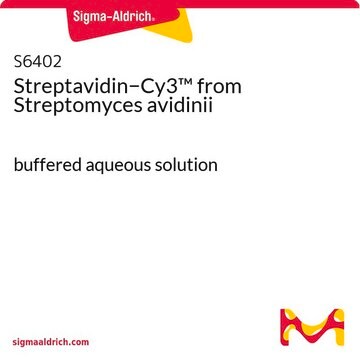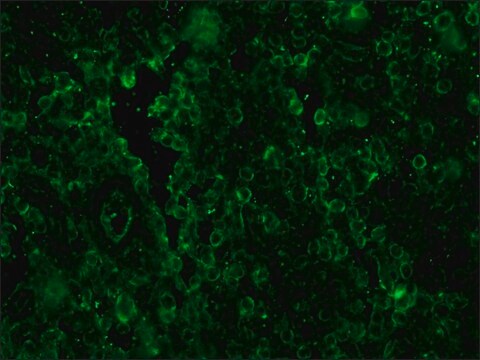11207741910
Roche
Anti-Digoxigenin-Fluorescein, Fab fragments
from sheep
Synonym(e):
anti-digoxigenin, digoxigenin
About This Item
Empfohlene Produkte
Biologische Quelle
sheep
Qualitätsniveau
Konjugat
fluorescein conjugate
Antikörperform
purified immunoglobulin
Antikörper-Produkttyp
primary antibodies
Klon
polyclonal
Form
lyophilized
Verpackung
pkg of 200 μg
Hersteller/Markenname
Roche
Isotyp
IgG
Lagertemp.
2-8°C
Verwandte Kategorien
Allgemeine Beschreibung
Spezifität
Anwendung
- Digoxigenin-labeled sugars in glycoconjugate research
- Fluorescent in situ hybridization (FISH)
- Immunohistocytochemistry
- In situ hybridization
Angaben zur Herstellung
- Working concentration: Working concentration of conjugate depends on application and substrate. The following concentrations should be taken as a guideline:Detection of digoxigenin-labeled sugars in glycoproteins: 50 to 20μg/ml
- Fluorescent in situ hybridization (FISH): 1 to 20μg/ml
- Immunohistocytochemistry: 20 to 50μg/ml
- In situ hybridization: 20 to 50μg/ml
The anti-DIG anitbody is highly specific and sensitive. Therefore, for FISH, a concentration of 1μg/ml is sufficient, and only in case of critical probes, this concentration may be raised to <10μg/ml (with a distinct background to be expected).
Working solution: Reconstitution
Add 1 ml double-distilled water to a final concentration of 200μg/ml.
Blocking:
PBS, 0.5% bovine serum albumin (w/v), pH 7.4.
1% Blocking reagent (w/v), 1 to 5% heat inactivated fetal calf serum (v/v) or sheep normal serum can be used for reduction of unspecific binding. Furthermore, pH can be increased up to pH 8.5 to 9.0.
Storage conditions (working solution): Always prepare fresh!
Rekonstituierung
Sonstige Hinweise
Not finding the right product?
Try our Produkt-Auswahlhilfe.
Signalwort
Warning
H-Sätze
Gefahreneinstufungen
Aquatic Chronic 3 - Skin Sens. 1
Lagerklassenschlüssel
13 - Non Combustible Solids
WGK
WGK 2
Flammpunkt (°F)
does not flash
Flammpunkt (°C)
does not flash
Analysenzertifikate (COA)
Suchen Sie nach Analysenzertifikate (COA), indem Sie die Lot-/Chargennummer des Produkts eingeben. Lot- und Chargennummern sind auf dem Produktetikett hinter den Wörtern ‘Lot’ oder ‘Batch’ (Lot oder Charge) zu finden.
Besitzen Sie dieses Produkt bereits?
In der Dokumentenbibliothek finden Sie die Dokumentation zu den Produkten, die Sie kürzlich erworben haben.
Kunden haben sich ebenfalls angesehen
Artikel
Digoxigenin (DIG) labeling methods and kits for DNA and RNA DIG probes, random primed DNA labeling, nick translation labeling, 5’ and 3’ oligonucleotide end-labeling.
Markierungsmethoden mit Digoxigenin (DIG) und Kits für DNA- und RNA-DIG-Sonden, DNA-Markierung durch Random Primer, Nick-Translationsmarkierung, 5‘- und 3‘-Endmarkierung von Oligonukleotiden.
Unser Team von Wissenschaftlern verfügt über Erfahrung in allen Forschungsbereichen einschließlich Life Science, Materialwissenschaften, chemischer Synthese, Chromatographie, Analytik und vielen mehr..
Setzen Sie sich mit dem technischen Dienst in Verbindung.








